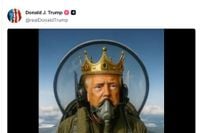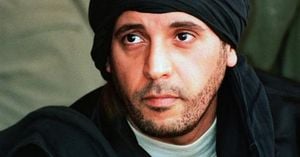On October 19, 2025, a wave of protest swept across the United States, as nearly seven million Americans participated in the so-called 'No Kings' demonstrations—an unprecedented show of dissent against President Donald Trump’s administration. The scale of the marches, which spanned all 50 states, was historic, but what truly grabbed headlines was the White House’s response: a barrage of AI-generated videos and images, shared by Trump and his allies, that mocked and belittled the protesters in ways both surreal and provocative.
According to The Independent, President Trump spent much of the day golfing before taking to Truth Social, his favored social media platform, to post an AI-created video that quickly went viral. In the video, Trump appears wearing a crown and flying a fighter jet emblazoned with the words “KING TRUMP.” As Kenny Loggins’ “Danger Zone” blares—a nod to the iconic Top Gun soundtrack—the digital Trump soars over a sea of demonstrators, apparently in Times Square, and dumps a stream of brown liquid onto the crowd below. The implication was clear, and the mockery stung.
The video, which was shared on both the president’s personal and official government accounts, drew immediate outrage from protesters and critics alike. The spectacle of the president depicting himself as a king, using military might against his own citizens—even in jest—struck many as a sign of deepening divisions and a lack of seriousness from the nation’s highest office. Yet the message from the White House and its allies was anything but conciliatory.
Republican leaders quickly echoed the president’s tone. House Speaker Mike Johnson dismissed the demonstrations as “Hate America” rallies, according to The Independent. Transportation Secretary Sean Duffy went further, suggesting that many protest participants were either pro-Hamas or paid agitators acting on behalf of Antifa—a group the Trump administration has officially designated as a domestic terrorist organization. The rhetoric was sharp, and the intention clear: discredit the protests by linking them to extremism and foreign influence.
Vice President JD Vance, never one to shy away from a social media moment, joined the fray by sharing his own AI-generated video. In this version, Trump dons a crown and cape, while prominent Democrats like Nancy Pelosi kneel before him. Other Trump-linked accounts posted a mock Time magazine cover featuring the president in regal attire and a video of Trump waving from the White House, draped in red velvet. The imagery was unmistakable—Trump as king, his critics as subservient, and dissent as something to be ridiculed or crushed.
For many observers, the White House’s embrace of AI-generated propaganda marked a new low in the administration’s handling of dissent. Critics accused Trump and his team of deliberately stoking unrest, hoping to provoke violence that could then be used as a pretext for invoking the Insurrection Act—a move that would allow the president to deploy military forces against civilian protesters and further militarize local law enforcement. “They’re clearly scared of peaceful opposition,” Indivisible co-founder Ezra Levin told The Independent. “This is not the response of a confident administration.”
This isn’t the first time the Trump administration has used digital imagery and social media spectacle to send a message. In September, as tensions mounted in Chicago over the possible deployment of the National Guard, Trump posted another AI-generated image: himself in a cowboy hat, military fatigues, and aviator sunglasses, with helicopters flying low over a city skyline engulfed in flames. The image bore the slogan “Chipocalypse Now”—a play on the 1979 Vietnam War film Apocalypse Now—and was accompanied by a caption: “I love the smell of deportations in the morning… Chicago is about to find out why it’s called the Department of WAR.” The message was clear: dissent would be met with force.
According to reporting from The Independent, the administration’s crackdown on dissent has not been limited to rhetoric and imagery. In recent months, federal immigration agents have been deployed to cities like Portland and Chicago, despite objections from local officials and protesters. The administration has also pushed to add National Guard troops in those same locations, citing the need to restore order and combat what it describes as left-wing extremism. These moves, combined with the digital taunts, have left many Americans worried about the direction of the country and the willingness of its leaders to listen to dissenting voices.
Republican officials, for their part, have largely doubled down on their criticism of the protests. House Speaker Mike Johnson and other congressional Republicans have maintained that the demonstrations are less about legitimate grievances and more about undermining the country itself. “These are Hate America rallies,” Johnson was quoted as saying, echoing the administration’s line that the protests are driven by radical elements rather than ordinary citizens. Secretary Duffy’s comments about Antifa and foreign influence have only added fuel to the fire, casting the protests as part of a broader conspiracy against the government.
Yet for the millions who took to the streets, the message was simple: opposition to what they see as the overreach and authoritarian tendencies of the Trump administration. Organizers of the No Kings protests have emphasized the peaceful nature of their demonstrations and have been quick to point out that attempts to link them to violence are nothing more than political theater. “They’re trying to paint us as dangerous to justify a crackdown,” said one organizer. “But we’re not backing down.”
The spectacle of the president and his allies embracing the imagery of monarchy—crowns, capes, kneeling opponents, and all—has struck a nerve, not just with protesters but with many Americans who worry about the health of their democracy. The use of AI-generated videos to mock and threaten dissenters is a new twist in the ongoing battle over the nation’s political soul, and it raises difficult questions about the boundaries of presidential power, the role of technology in political discourse, and the future of protest in America.
As the dust settles from this weekend’s massive demonstrations, one thing is clear: the divide between the Trump administration and its critics has never been wider. With both sides digging in and the rhetoric growing ever more heated, the coming months are likely to bring more protests, more digital spectacle, and more questions about what kind of country the United States wants to be.




